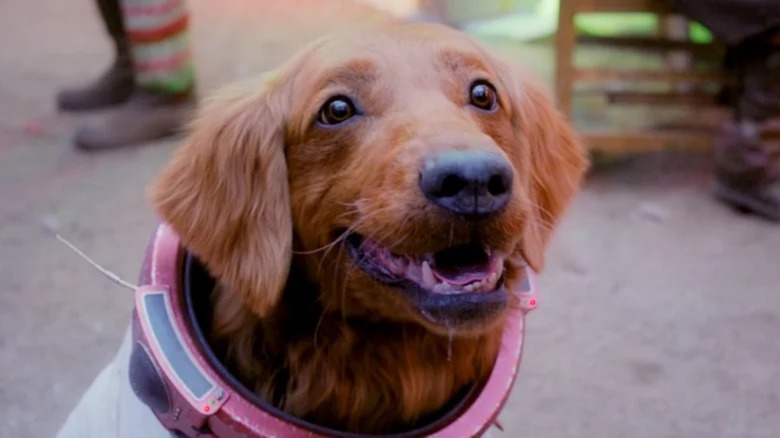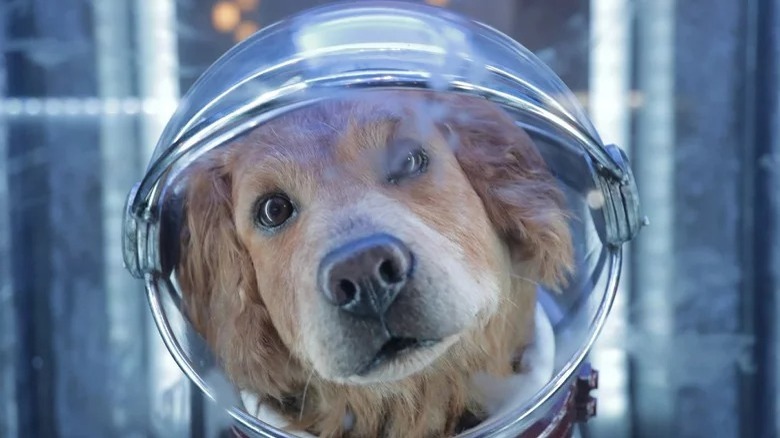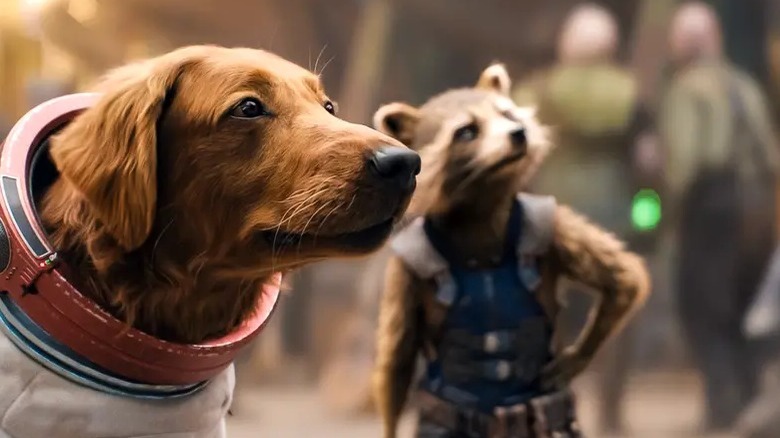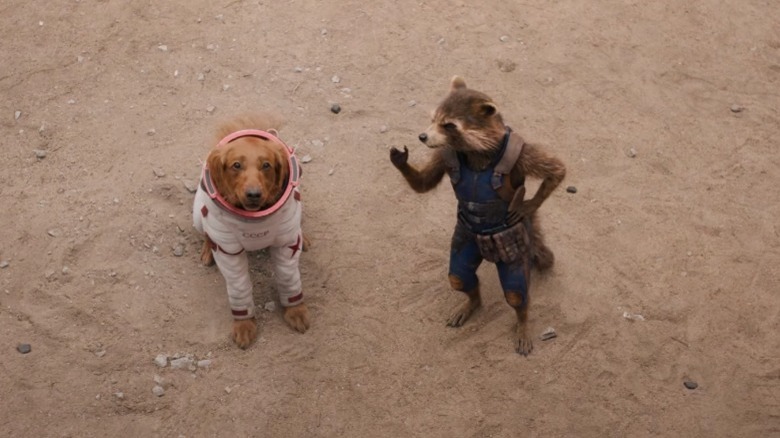Guardians Of The Galaxy Vol. 3's Cosmo Is Based On The Tragic True Story Of Laika The Space Dog
The "Guardians of the Galaxy" franchise has introduced plenty of colorful characters over the past decade, from a talking raccoon named Rocket, to a sentient tree named Groot, to the antennae-sporting alien, Mantis. Yet few new additions have been as instantaneously accepted as friend-shaped like Cosmo, the adorable space dog voiced by Maria Bakalova in "The Guardians of the Galaxy Holiday Special." So far, we've only gotten a bit of screen time with Cosmo, but we know that she's telekinetic, loves Kevin Bacon, took a liking to Sean Gunn's Kraglin, and is, in the parlance of dog owners, "food motivated."
Cosmo also wears a pretty distinctive outfit: she's decked out in an old-fashioned spacesuit that's a bit like the kind astronauts wore during the Space Race. It features a patch that says CCCP and a rust red collar opening that could connect to a helmet — complete with what looks like a tiny sensor antenna. It's a decidedly weird getup for a dog, but it makes sense when considering Cosmo's origin story: in Dan Abnett and Andy Lanning's 2007 comic run, "Nova," Cosmo is introduced as a dog who survived experiments from the Soviet Space Program (aka CCCP) in the 1960s.
The Marvel Comics version of Cosmo is actually a good boy rather than a good girl, but James Gunn's films reintroduced the character as a female dog in reference to the real-life critter that inspired her: Laika, a stray dog that the Soviet Union sent into space in 1957. While Laika didn't make it back to Earth, Marvel Comics' Cosmo got lost in space, arriving on the planet Knowhere after being subject to random cosmic rays that turned him into a superdog complete with telekinetic and telepathic powers. It's a sweet rewrite of what is, in reality, a truly tragic story.
A brief history of animals in space
To understand how poor Laika ended up on a rocket with no plans for an earthly return, it's important to understand the context of space travel in the 1950s. By the time Laika went on her one-way mission, the U.S. and the Soviet Union were years into the Cold War, a conflict that would last decades and involve espionage, bloodshed, and perhaps most surprising, lots of cultural competition. Both nations wanted to prove their mettle (and the validity of their respective political ideologies) by being the first to put a man on the moon, but before humans could safely make it to space, animals were sent in their place.
According to the Royal Museums Greenwich, the first known animals in space were fruit flies, which were sent 67 miles into the air in 1947 by Americans who were curious about how cosmic radiation might impact biological structures. Soon, scientists started using mammals like dogs and monkeys in order to figure out exactly what astronauts would need to be prepared for when leaving Earth, as well as what spacesuits and other onboard technology could do to mitigate the effects of space travel.
While it's tough to imagine an alternative method of rudimentary research that wouldn't kill lots of astronauts in the process, the use of animals in early space travel experiments is no doubt extremely upsetting. Many animals died over the course of the Space Age, but few stories are as tragic as Laika's. According to Smithsonian Magazine, the dog, who is often cited as part Samoyed but in images also appears to be part terrier, was chosen from among several stray dogs from Moscow for the mission aboard Sputnik 2. Like Cosmo, she had special gear for her travels, including a diaper-like affixed bag, a harness, and electrodes to capture readings on her vitals throughout the journey, per NASA.
Laika's orbit was doomed from the start
Laika's audition process was pretty involved. According to Smithsonian, she was chosen after passing tests measuring her obedience as well as her reaction to changes in pressure and noise volume. She also had to endure weeks of life spent in a small, pressurized capsule, ostensibly to prove to scientists that she would be able to stay alive long enough to send back readings that would tell scientists whether or not humans could survive time in orbit. Unfortunately, though, when the time came for Laika's mission, she likely died soon after takeoff due to the fact that the rocket's heat shield insulation broke during takeoff, making temperatures inside rise to an intolerable degree.
The pup, who was originally called Kudryavka ("Little Curly") before her name changed to Laika ("barker"), is now remembered as the first living being ever to reach orbit. Undoubtedly beloved, Laika has been the subject of a commemorative stamp, an Arcade Fire song, a graphic novel, and Lasse Hallström's acclaimed film "My Life As A Dog," not to mention the latest Marvel movie. Still, none of that erases the tragedy at the heart of Laika's story. The pet was given little food for her journey, and no plans were made for Sputnik 2 to land. The plan for her death was by some measures even worse than the reality, as scientists originally expected her to die from oxygen deprivation days after entering orbit. Early animal rights protestors reportedly couldn't stop her mission, as Space.com states that the launch had a hard deadline — the 40th anniversary of the Bolshevik Revolution — that left only four weeks for the entire aircraft build.
From propaganda pawn to superpowered pup
Sputnik 2's politics-centric launch date seems to have been fueled by propaganda, but so was her return — or lack thereof. Smithsonian curator Cathleen Lewis told the magazine that the Soviet Union continued telling the public that Laika was alive for over a week after the launch, and she says that documents about her mission "were falsified." It's no surprise that, given this tragic context and the strange, false hope surrounding Laika's story, creators like Dan Abnett, Andy Lanning, and James Gunn would be eager to reimagine the story of Laika as one of mystery and limitless exploration. Cosmo has by no means had an easy life, but in Marvel Comics, he ends up a dog with a less deadly job: head of security on Knowhere. Plus, Cosmo has superpowers, a lovingly creative addition for a dog based on a real-life animal who was sadly all too powerless.
We'll find out exactly how much Cosmo's on-screen story will call to mind Laika's when "Guardians of the Galaxy Vol. 3" arrives in theaters on May 5, 2023.



